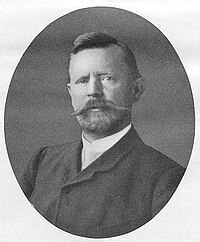Carl Humann
| Carl Humann | |
|---|---|

Carl Humann
|
|
| Born |
4 January 1839 Essen |
| Died | 12 April 1896 (aged 57) İzmir |
| Nationality | German |
| Fields | Archaeology |
| Known for | Pergamon Altar |
Carl Humann (first name also Karl, born 4 January 1839 in Steele, part of today’s Essen - Germany; † 12 April 1896 in Smyrna, today İzmir - Turkey) was a German engineer, architect and archaeologist. He discovered the Pergamon Altar.
Humann, an educated railroad engineer and aspiring architecture student, he worked initially on the construction of the Bergisch-Märkische Railway in North Rhine-Westphalia—position he got through help from his older brother Franz, who had been working there—and later attended the Building-Academy in Berlin. Due to him falling ill to tuberculosis, he looked for warmer climates and moved to the then Ottoman Empire and settled down in Istanbul. He participated in excavations on the island of Samos—joining his brother Franz, who had been working on the Heraion sanctuary—, building palaces and travelling in 1864 through Palestine, under order of the Ottoman Empire, drawing up accurate maps of the area. His work as a surveyor for the railway and road construction departments helped him gain a personal familiarity with classical-era ruins, as well as develop an extensive network of contacts and acquaintances.
He never studied archaeology or took an advanced degree of any kind, exemplifying the nineteenth-century self-made archaeologist, akin to Heinrich Schliemann and Wilhelm Dörpfeld. He was representative of a generation of rough and ready pioneers, who had developed an antipathy for philologists and got easily aggravated by their slow and careful approach to excavations (Schuchhardt, 1931). On the other hand, Humann established extensive connections throughout the whole of the Ottoman Empire, with local officials as well as workmen, which earned him the nickname “Viceroy of Asia Minor” and the very important esteem of the director of the Turkish Museums, Osman Hamdi Bey (Schulte, 1974).
From 1867 until 1873 he supervised the construction of roads in Anatolia. As part of his preparation, he visited in the winter of 1864/65 the site of the antique Pergamon. In this historical site, he used his influence to stop the destruction of the partly unearthed marble ruins. Although he already showed a high interest in starting excavations in this area, he still needed the official support from Berlin.
...
Wikipedia
